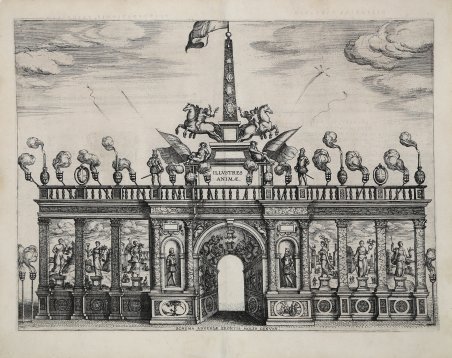Arco monumentale, sormontato da obelisco, decorato con figure emblematiche. Acquaforte e bulino, 1599 circa, priva di firma, impressa su carta vergata coeva, con margini, testo descrittivo al verso, in ottimo stato di conservazione. Raffigura un arco trionfale eretto in onore di Alberto d’Austria e Isabella di Spagna. L’opera è una delle illustrazioni di uno dei più bei libri di feste fiamminghi, la ' Historica narratio profectionis et inagurationis serenissimorum belgii principum Alberti et Isabellae, Austriae Archiducum. Et eorum optatissimi in Belgium Adventus ' di Johannes Bochius, stampato con imprint Ex ' Officina Plantiniana apud Joannem Moretum, Antuerpia, 1602. Il libro descrive e illustra i festeggiamenti che si svolsero nelle città di Bruxelles, Anversa, Gand e Valencia in onore dell'arrivo nel 1599 degli arciduchi d'Austria, il principe Alberto e sua moglie, la principessa Isabella di Spagna, figlia di Filippo II, come reggenti dei Paesi Bassi. Le straordinarie tavole sono state eseguite integralmente da Pieter van der Borcht (1545-1608), allievo di Pieter Breughel, considerato uno dei grandi incisori del suo tempo. Le dettagliate illustrazioni della presente opera raffigurano gli archi di trionfo, le processioni, i fuochi d'artificio, i teatri e altre decorazioni effimere che venivano erette nelle rispettive città al passaggio del seguito. Particolarmente degno di nota è il dettaglio con cui vengono illustrati gli usi e i costumi degli abitanti e i dettagli architettonici delle case e degli altri edifici, delle strade e delle piazze pubbliche, soprattutto ad Anversa. Secondo Delén (1934, p. 97) le stampe di Van der Borcht rappresentano il passaggio intermedio tra le illustrazioni di stile manierista realizzate da Pieter Coecke per l'ingresso di Filippo II e quelle pienamente barocche di Rubens per il Cardenal Infante. Bibliografia Sconosciuta ad Hollstein; J. J. Delén, ' Le XVIe siècle. ' Les graveurs-illustrateurs. ' Paris: Les Èditions d'Art et d'Histoire, 1934, p. 97; Margit Thøfner, ' Marrying the City, Mothering the Country: Gender and Visual Conventions in Johannes Bochius's Account of the Joyous Entry of the Archduke Albert and the Infanta Isabella into Antwerp, in “Oxford Art Journal”, Vol. 22, No. 1 (1999), pp. 1-27; Praz, 23. Hiler, 95. Lipperheide, 2657. Graesse I, 458. Monumental arch, surmounted by obelisk, decorated with emblematic figures. ' Etching and engraving, 1599 circa, lettered with title and motto within image; verso lettered with text pp.231, 234. A fine impression, printed on contemporary laid paper, with margins, very good condition. ' It depicts a triumphal arch erected in honor of Albert of Austria and Isabella of Spain. The work is one of the illustrations in one of the finest Flemish festival books, the Historica narratio profectionis et inagurationis serenissimorum belgii principum Alberti et Isabellae, Austriae Archiducum. Et eorum optatissimi in Belgium Adventus by Johannes Bochius, printed with imprint Ex Officina Plantiniana apud Joannem Moretum, Antuerpia, 1602. ' The book describes and illustrates the festivities that took place in the cities of Brussels, Antwerp, Ghent and Valencia in honor of the arrival in 1599 of the archdukes of Austria, Prince Albert and his wife, Princess Isabella of Spain, daughter of Philip II, as regents of the Netherlands. ' The extraordinary plates were executed in their entirety by Pieter van der Borcht (1545-1608), a pupil of Pieter Breughel, considered one of the great engravers of his time. The detailed illustrations in this work depict the triumphal arches, processions, fireworks, theaters and other ephemeral decorations that were erected in the respective cities as the retinue passed through. Particularly noteworthy is the detail with which the customs and habits of the inhabitants are illustrated and the architectural details of houses and other buildings, streets and public squares, especially in Antwerp. ' According to Delén (1934, p. 97), Van der Borcht's prints represent the intermediate step between the Mannerist-style illustrations made by Pieter Coecke for the entry of Philip II and the fully Baroque ones by Rubens for the Cardenal Infante. ' Bibliografia Not in Hollstein; J. J. Delén, Le XVIe siècle. Les graveurs-illustrateurs. Paris: Les Èditions d'Art et d'Histoire, 1934, p. 97; Margit Thøfner, Marrying the City, Mothering the Country: Gender and Visual Conventions in Johannes Bochius's Account of the Joyous Entry of the Archduke Albert and the Infanta Isabella into Antwerp, in “Oxford Art Journal”, Vol. 22, No. 1 (1999), pp. 1-27; Praz, 23. Hiler, 95. Lipperheide, 2657. Graesse I, 458. Cfr.

Descubre cómo utilizar
Descubre cómo utilizar

